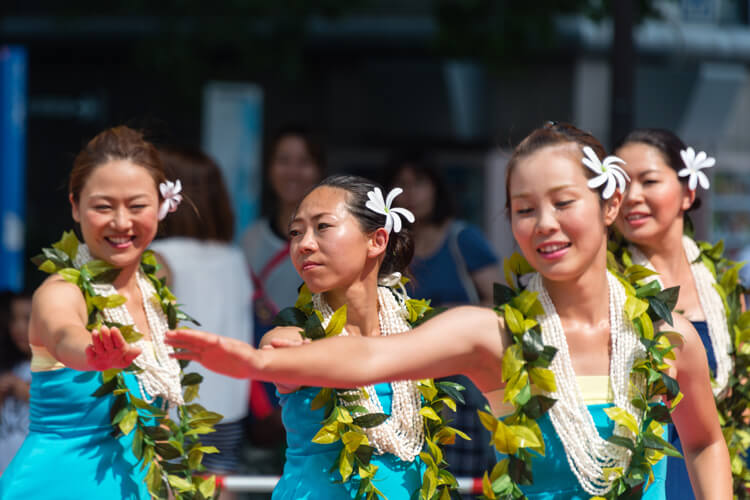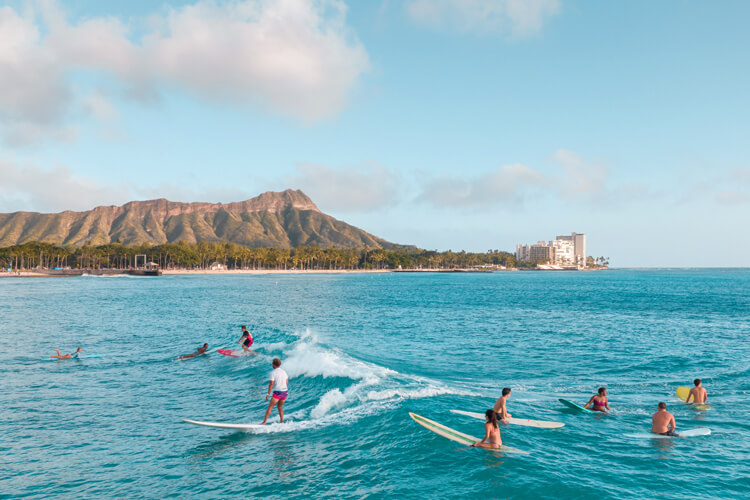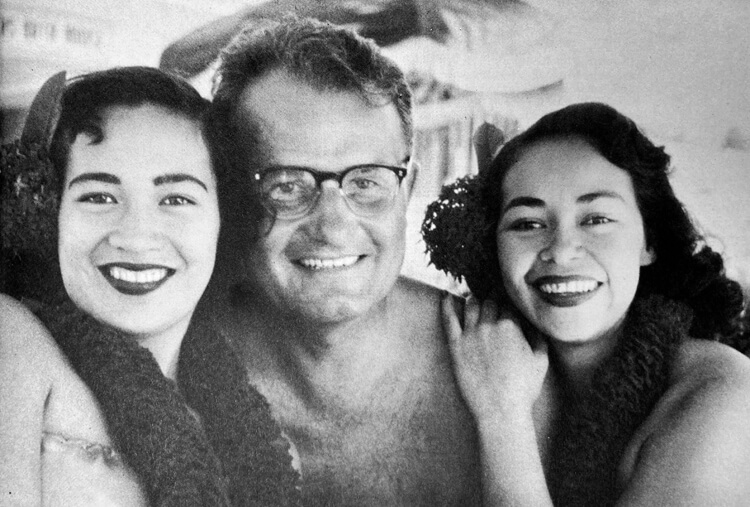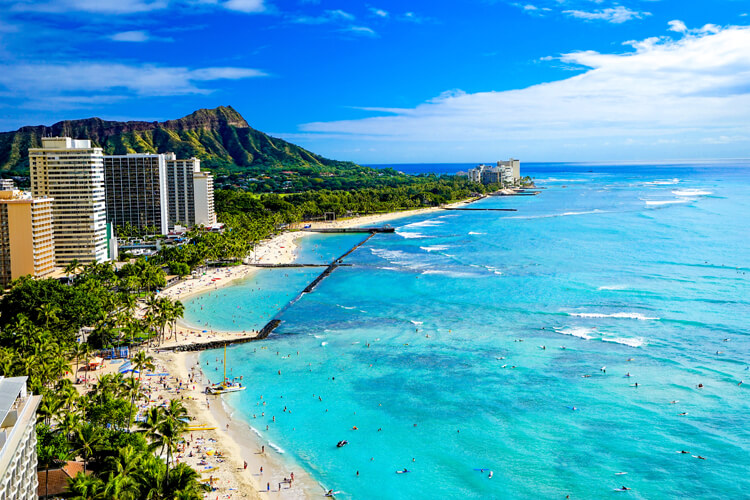A man's first visit to Hawaii is like coming home after a long exile in a foreign country.
Such is Hawaiian hospitality that the meanest stranger, an outcast in his own society, will soon be an accepted member of the island scene.
Scrooge would be inconceivable as a serious character in a novel about Hawaii.
For those who forsake her for other shores, Hawaii is the eternal woman, ever faithful, always waiting for her man's return to her calm and gracious ways.
On your first visit to Hawaii, you should leave the U.S. mainland in the cold of winter.
In a few hours, you are in a different world.
You can hear the trade winds sighing high in the coconuts, and as you disembark from the giant silver jet and feel the first warm flush of incense-laden air against your cheeks, you will feel certain that you have landed in Paradise.
I must confess that I had always reacted strongly against the advance publicity and ballyhoo of the Hawaiian Visitors Bureau, as I'm sure that many others do.
I had landed in Hawaii, more or less by accident on my way to Australia, to take in the Olympic Games, for which I've always had a weakness.
I was fully prepared to dislike the place intensely.
I soon discovered something that so many people had found before me - many of whom had come to the Islands by accident and who had stayed a lifetime - simply that advertising and travel folders can't begin to describe Hawaii as it really is.
The finest fleet of islands that lay anchored in any ocean, Mark Twain had called them.
"... In my nostrils still lives the breath of flowers that perished twenty years ago," he had said in nostalgic recollection.
Beauty, of course, there is in abundance: Beauty in the Gauginesque colors of the landscape, the greenness of the foliage, the orange earth, the blue sea, and the white surf; beauty in the magnificent mass of carved lava called the Koolaus, and in the giant sculpture of the monkey pods and banyan trees.
Honolulu is a forest city, where most buildings are soon engulfed by the luxuriant screen of leaves and flowers, which flows unchecked from the mountains to the sea.
No wonder Hawaii was christened "The Fragrant Tree Country" by the immigrant Chinese who came to harvest the sugar cane.
Even a few hours in Honolulu, however, will convince you that there is much more than physical beauty in Hawaii and much more in that first greeting than the flower-scented winds.
And quite suddenly, you will realize what's causing it.
There's love in the air; love for everyone regardless of their color, creed, or racial origin.
For the true Hawaiians have the largest hearts, the warmest smiles, and the kindest dispositions of any people the world has ever known.
In Hawaii, all this is wrapped up in the one word, aloha, the magic island greeting, which means simply "my love to you."
It is this spirit of aloha which hits you when you leave the plane at Honolulu Airport, and in spite of the recent efforts of beady-eyed developers, it is still present in Waikiki.
And that, of course, is where the surf is! - which, before I get further carried away, brings us back to our subject.

Waikiki Beach
Waikiki Beach is a wide sand crescent which penetrates the coastal plain of urban Honolulu; it is backed by the eternal green of the Koolau range and accented by that noble landmark Diamond Head.
The center of the beach is a multi-colored welter of competing hotels of various shapes, sizes, and architectural styles, with here and there a fringe of waving coconuts, gradually becoming continuous, to form a ruffle round the base of Diamond Head.
Beyond and behind the hotels, there is a continuous strip of open area - park, golf course, and army camp, which provides a welcome counterpoint to the stark denseness of the buildings, and at the same time, isolates Waikiki from the mountains.
These, in turn, provide the vertical measure for the incredible sense of space which the whole scene creates.
In front of the sand, the pounding blue and white surf reaches endlessly toward the beach, while high in the air, a few small white clouds float calmly in the almost continual sunlight.

Taking Up Surfing
My first efforts at surfing took place at Waikiki Beach in December 1956.
Hanns Hubmann (pronounced Hoopman), a German photographer from Munich, accompanied me to the beach, where we were greeted by Gilbert Minn, an Islander of Korean ancestry who came from a noted family of Island sportsmen.
Hanns [pictured below] was at that time 49 years old, but he was fit and vigorous. He grandly informed me he was the highest-paid photographer in Europe.
(In return to which I quoted Oscar Wilde - that "genius is born, not paid.")
Gilbert, it turned out, was really an engineer working for the government, but he taught surf-riding and ran a surfboard concession on the side, as well as stamping plans which needed a licensed engineer's approval and anything else he could think up to make an honest dollar.
I found out that nearly everyone in Hawaii has two jobs.
(One is invariably for the government.)
This is possible because nobody works hard enough at either one of them to get as tired as a man working a steady eight hours elsewhere in the world.
Gilbert would teach us "all about surfing" for $2 a lesson - and although this very reasonable sum has recently been upped to $4, I recommend anyone with surfing aspirations to take a few lessons, if only to familiarize himself with the board and the surf, to learn to paddle and to overcome more quickly a few of the more natural fears and inhibitions.
Hanns and I, in turn, lay on the boards, safely riveted in the sand by their skegs and forcibly held in front by Gilbert.
He showed us that, to paddle, we must get the board on an even keel, which is really a matter of feel and comes rapidly with experience.
"Stand up," said Gilbert, and we clumsily rose to our feet as the board wobbled furiously.
He then showed us a typical stance - knees bent and the body leaning slightly forward, with the front foot, preferably the left pointing forward, and the trail foot pointing outward about a foot behind the front foot.
After that, we were ready.
The water at Waikiki, although I will describe it in more detail later, is shallow, and when the tide is out, you can walk out a quarter of a mile without getting out of your depth.
When the tide is up, this figure is reduced to two or three hundred yards, and even in this area, there are pockets of deeper water.
This shallow condition due to the reef is the cause of the surf, since the waves as they reach the shallow water become steeper and eventually break.
The more gradual the change from steep water to shallow, the longer the wave is rolling before it breaks, and the longer and better the ride for the surfer.
This shallow water makes Waikiki an ideal area for beginners.
Soon the three of us had gaily placed ourselves right in the middle of the area known as Canoe Surf, about 350 yards from the shore.
The water there was about five feet deep.
Paddling out had exhausted me to the point where I now wanted half an hour's rest, but Gilbert had other ideas.
The waves where we stood were about two and a half feet high and were breaking spasmodically, about a hundred yards farther in.
The sea between the waves was smooth.
Gilbert, who was standing at my side, motioned me to prepare to go since a better than average wave approached.
With a violent push, I felt the board take off and lift as it came into the grip of the wave, a quite incredible sensation the first time you experience it.
There was a rushing noise as the swirl of blue, green water was churned into a foamy wake by the board, and as if from another world, I heard Gilbert's gigantic stage whisper, "Stand up."
To my amazement and horror I did so, waiting at any moment for something unknown and terrible to occur, but instead I rode rather shakily for a hundred yards or so, hoping against hope that the board would somehow keep going and that the unearthly exhilaration would continue.
About halfway along, the wave gradually began to lose momentum.
At the end, instead of sitting down, and so stalling the board which I should have done, I flopped untidily into about four feet of water, a confused mass of arms and legs.
The ride was very exciting but tantalizingly short. I became determined at that moment that somehow I would learn to surf.
Meanwhile, the board which I had vacated sailed merrily on shoreward, narrowly missing two swimmers and another surfer returning from a ride.
It was a redwood board weighing about 60 pounds, I suppose, and it occurred to me if it hit you from behind, it would not be good for earache.
I learned at that moment one of the cardinal rules of surfing. Free-floating boards can be almost as dangerous as a loaded revolver or a shark.
Indeed they are more dangerous than sharks, as more injuries can be traced to them than are attributed to these normally apathetic fish.
So grab hold of your board when you are about to fall off. Fall on it or push the rear end down to pull it out of the wave.
After retrieving the board, I asked Gilbert about accidents - he dismissed this query with a munificent wave of his hand and a scornful look, and I gathered that in spite of the large number of people surfing and the heavy boards, accidents were rare.
The next day I met a man who was wearing his head on a slant and was cheerfully told he had broken his neck surfing.

Shooting the Surf
After my first effort, which was really nothing to boast about, as those old redwood boards were very stable, Hanns decided to hire an outrigger canoe so that I could photograph him for his magazine and he could photograph me.
Armed with a battery of cameras and with Gilbert aboard, we returned to the surf.
It was Hanns' turn, and Gilbert got ready to push him.
Hanns was lying on the board in a rather ungainly manner which reminded me, quite unfairly of course, of the joke about the pregnant turtle; although looking back, I'm sure I looked just as bad myself.
His naturally confident manner had begun to evaporate, and the sea was now a good bit choppier as the Trades were coming up.
Suddenly along came a wave a little larger than before, and Gilbert lunged at the board, simultaneously uttering the magic words, "Stand up."
The board shot of like a rocket, I put the camera into action, Hanns got up rapidly and ungracefully at Gilbert's command, his right foot shot forward;
for a full second, he was suspended in mid-air - with a look of sheer disbelief that such a superior person should be so poorly treated - then, with an ugly crash, he descended into the ocean depths and disappeared.
Seconds later, he came to the top, sucking violently at the good fresh air and hurling a torrent of censure at poor Gilbert.
"Thees 'ees reediculous, thees 'ees absurd, you have not pushed me right, how can I stand up with such a push. It is reediculous, it is terrible. Desmont, I am very annoyed with you, how can I stand up on this board? It does not go straight," etc., etc.
Fortunately for Hanns' self-respect, my second go must have been just as bad since he, Gilbert, and the canoe crew were all shaking with vulgar laughter when I came to the surface.
So Hanns had another go, but again without luck, and so on for several more attempts.
For some reason or another, he didn't seem able to keep his balance; he would stay on all right for five or ten yards and then gradually fall into the water as if in a slow-motion film, complaining bitterly each time about the loss of push, the inadequacy of the waves, and the inefficiency of Gilbert and myself for not looking right!
By the eighth or ninth push, Hanns was in a passion, and at this point, few of us could blame him.
To avoid embarrassment, we were praying fervently for his success.
Meanwhile, the small Hawaiian boys were skimming from side to side of the breakers with insolent ease, and the outrigger canoe crew were grinning shamelessly, while I, for lack of anything better to do, took pictures of poor Hanns flopping awkwardly into the sea and emerging with his head bobbing in the soup, making enormous slurping sounds, his mouth forming a great cavern as he came up like a walrus for air.
(Hanns later sent me some of his photographs but said the camera had jammed on those I had taken of him. This seemed odd as all the several hundred pictures he had taken of high-breasted Hawaiian girls came out without a hitch.)
The Finest Exercise on Earth
Fortunately for our future relations, on his twelfth attempt (I had long since stopped myself to avoid tieing up the board), he managed to stay up on one of the best waves of the afternoon and executed a magnificent left slide right into the beach.
This entirely changed his attitude toward surfing, and for the next four days, we both achieved a certain proficiency, with Gilbert's continued help, although, of course, you can't learn very much in just a week.
We did manage to go down every day, usually at about four in the afternoon since we found that, otherwise, the strong sun beating off the sea made our heads ache.
One very welcome result of my surfing efforts was that I began to feel reasonably fit again since surfing, as you will find out, is the finest exercise on earth - you can't surf regularly and not be fit - and for girls, it's the finest method of slimming yet devised.
One girl, a secretary from Nebraska, had only been surfing for two months and was so spare you could almost see her bones.
She had been "quite fat," she said when she first started to surf.
Hanns, as I have already indicated, was in amazingly good condition for his 49 years. He had a simple formula for this.
In between his bouts of photographing Bridget Bardot and Anita Ekberg, he always swam every day of the year wherever he was, even if he had to break the ice!
Only because, I told myself, of this unfair state of fitness, at the end of the week, Hanns was better than I was.
This honorably relieved him of the unfortunate beginnings, and I'm glad to say he was as magnanimous in success as he had been bitter in failure.
When it came time to go, we reluctantly said goodbye to each other and to the many friends we had made.
We should not have been surprised, but they were nearly all at the airport to see us off, complete with Gilbert, who in typical Island fashion, had spent a good proportion of the money he had made from our surfing lessons to purchase flower leis with which to drape us on our departure.
It was with heavy hearts that we said goodbye to surfing and to Hawaii and to all its wonderful people, consoled to some extent by the certain knowledge that someday we'd be back.
Words by Desmond Muirhead | Golf Course Designer and Author of the Book "Surfing in Hawaii" (1962)
Chapter III of "Surfing in Hawaii" was published under the authorization of Rosemary J. Muirhead, one of the three daughters of Desmond Muirhead
